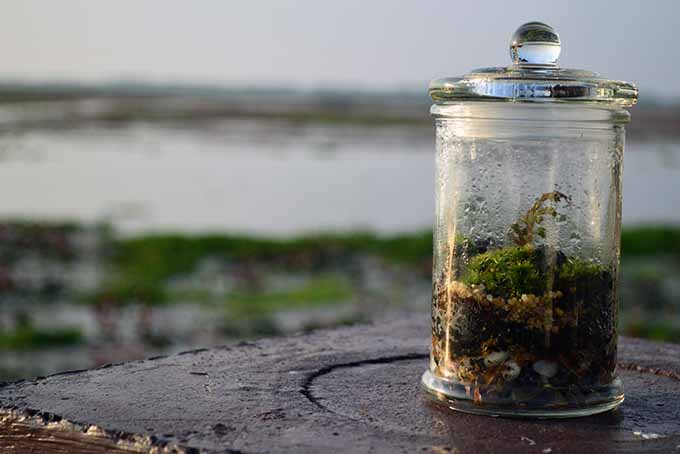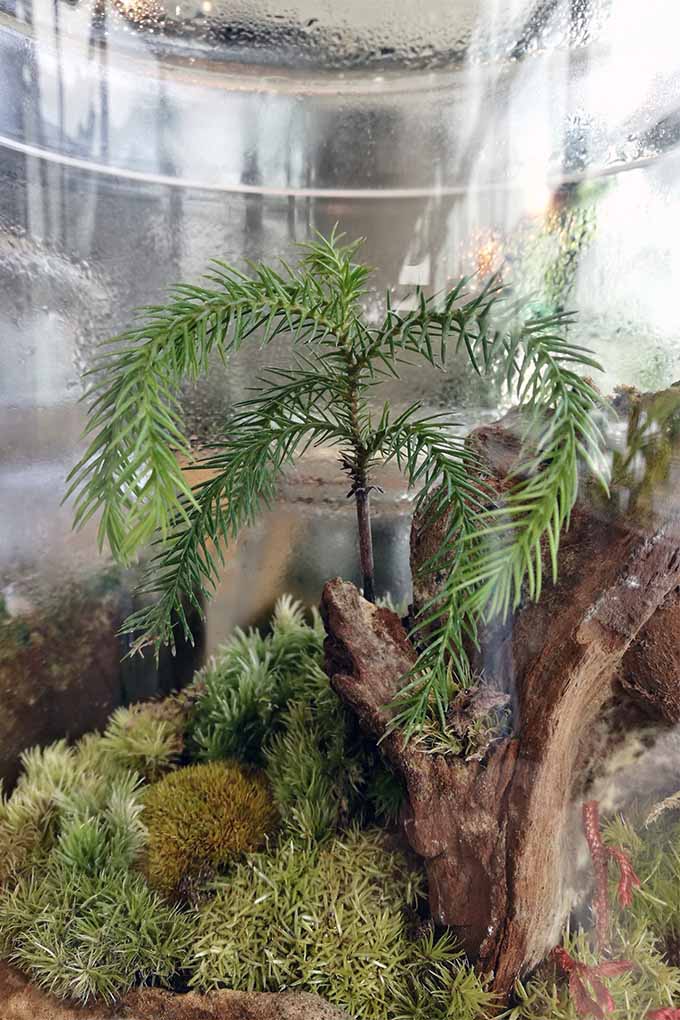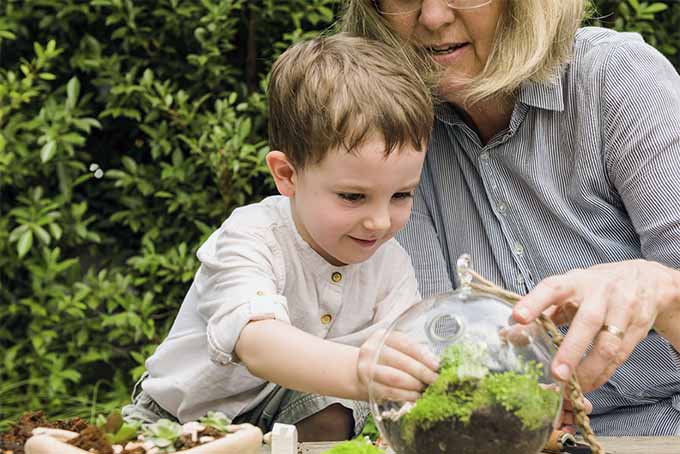In Victorian times, renowned physician Nathanial Bagshaw Ward was pursuing a passion for botany and conducting an experiment with moths, when he discovered that he could cultivate rare ferns inside a bottle. This led him to develop a glass vessel for nurturing imported plant specimens. The “Wardian case” is the predecessor of the terrarium. Traditionally made of curved glass with a tight-fitting lid, a terrarium has a base of gravel, charcoal, moss, and soil, and supports a miniature garden of moisture-loving plants.
Imaginary Landscapes
Think back to elementary school. Did you ever make a diorama project? In addition to the closed container in which the rain cycle creates a self-supporting mini garden, there are other types of plant arrangements that fall under the terrarium umbrella. Some folks place potted plants in a closed tank-type container resembling a Wardian case.
Cheviot Glass Terrarium by Gracie Oaks A glass terrarium that’s just right for this type of display is available on Wayfair. This is a great container for moisture-loving varieties like orchids, which we will mention again a bit later. Another is the glass cloche, a bell-shaped cover that also dates to Victorian days. CYS Clear Glass Cloche The cloche was often used to protect tender plants in the garden. Used indoors today, it is an attractive and functional enclosure for nurturing moisture-loving plants. Hanging Terrarium Air plants, cacti, and succulents are good low-maintenance choices for this modern-style terrarium. We’ve learned that plants that require a humid environment do best in a closed or partially closed container, where moisture builds up inside. Plants that like drier conditions do best in more open containers, where air circulates and the humidity is low. With this knowledge, we can choose the right container for the right plants. Let’s get started! I remember finding a shoebox and making a three-dimensional scene from a story to present to the class. Well, a terrarium can tell a story, too. Think of it as a miniature landscape you’d love to step inside and explore. Four of my favorite themes are:
Fairy Garden Woodland Hike Island Getaway Southwest Scene
Read on to visualize each theme, collect supplies, and make your own mini garden!
Fairy Garden
Imagine a magical place with surprises around every bend. Pebble paths, toadstools on mossy hills, tucked-away cottages, and animals peering through lush foliage set the stage for a fanciful theme. For a Fairy Garden, use plants like:
Goldfish plant (Alloplectus nummularia) Job’s tears (Pilea depressa) Lemon button fern (Nephrolepsis cordifolia ‘Duffii’) Meadow spikemoss (Selaginella apoda) Polka dot plant (Hypoestes phyllostachya) Rockfoils (Saxifraga)
These moisture-loving plants thrive self-sufficiently in a closed container. If you choose an open vessel, mist the soil thoroughly whenever it feels dry.
Woodland Hike
Picture yourself clad in hiking gear, using your walking stick to climb rocky outcroppings between whispering pines, while a swift river flows below. These are the images evoked with a woodland hike theme. For a Woodland Hike, use plants like:
Baby tears (Helxine soleirolii) Bugleweed (Ajuga reptans) Pennsylvania clubmoss (Lycopodium hickeyi) Peperomia (Peperomia perciliata) Mini English ivy(Hedera helix) Sweet woodruff (Galium odoratum)
These plants do well in a closed container. If you choose an open one, mist thoroughly whenever the soil is dry to the touch.
Island Getaway
Have you vacationed in a tropical paradise where dense exotic plants give way to turquoise oceans and white sand beaches littered with shells? Bear this scene in mind when you create your island getaway. For an Island Getaway, use plants like:
Alpine balsam (Erinus alpinus) Dwarf creeping fig (Ficus pumila ‘minima’) Dwarf Western maidenhair fern (Adiantum aleuticum ‘Imbricatum’) Earth star bromeliad (Cryptanthus) Inch plant (Tradescantia zebrina) Purple waffle (Hemigraphis alternata)
Purple waffle is one of five “clean air” plants discussed in our article on nontoxic houseplants.
Southwest Scene
Astride a palomino on a pebbly, parched riverbed, cacti and succulents dot the landscape as you pass. Use this vision to fashion a Southwest scene so realistic you can feel the sun on your back as you ride. The Moss Acres company is a wonderful source of all things moss. They offer a terrarium moss kit that contains three types of “landscape-quality” moss, for a total of one square foot of plant material.
Terrarium Moss Kit The fern is another plant that’s great for creating mini landscapes. Its fronds add height, to give the illusion of a canopy of foliage.
Mini Ferns for Terrariums
For a Southwest scene, use plants like:
Air plants (Tillandsia) Blossfeldia cactus (Blossfeldia liliputana) Dwarf agave (Agave desmettiana) Dwarf chin cactus (Gymnocalycium baldianum) Hens and chicks (Echeveria) Stonecrop (Sedum)
This arrangement is perfect for an open container. Mist occasionally.
How to Make a Terrarium
Now that you’ve chosen your theme and plants, decide where you’ll place your mini garden when it’s finished. For even more mini garden projects to create at home, we suggest checking out Creative Terrariums: 33 Modern Mini-Gardens for Your Home by Enid G. Svymbersky. This book includes tips for getting started and maintaining your terrariums, as well as a collection of DIY projects with illustrated step-by-step instructions, thorough materials lists, and helpful tips. If it will be viewed from all sides, keep this in mind as you arrange your plants in a way that is pleasing to look at from every angle. If your container will be seen only from the front and sides, be sure to have these sides show to best advantage. Let’s begin! For all projects, you will need:
Supplies:
Activated filtering charcoal Chopstick or pencil Close-fitting surgical gloves (optional) Container with a tight-fitting lid, or an open container Decorative sand (optional) Figurines (optional) Long tweezers Modeling clay (optional) Newspaper Pebbles or pea gravel Plants (see above) Potting soil appropriate for your plants Sphagnum moss Tiny trowel or long-handled spoon Water mist spray bottle
Activated filtering charcoal is used to kill bacteria, and to deodorize your arrangement. Newspaper is an excellent asset for any gardening craft project. I like to keep it on hand to spread out before I get started, to protect my work surface. Decorative sand is optional for surface decorations, and miniature figurines are an optional decorative addition that’s great for setting the scene. Modeling clay is great to have on hand to create a base for containers that are likely to roll. To help your plants to thrive, it’s important to set up your terrarium with the appropriate soil. African violet potting mix is a great choice if this is what you’ll be planting, or cactus mixtures that are light and loose work well for planting southwestern favorites like succulents and cacti. (And speaking of African violets, you can learn more about propagating them here…) Sphagnum moss is perfect for layering, and it comes in handy for surface planting as well.
Instructions:
Choose a theme and select appropriate plants (see below) and accessories.
Wash container, tools, pebbles/stones, and figurines with mild dish soap and water before assembly. Rinse thoroughly and dry with paper towels.
Spread newspaper over your work surface.
Decide whether you will use your container horizontally or vertically.
Cover the bottom of the container with a layer of pebbles.
Cover the pebbles with about an inch of activated charcoal.
Cover activated charcoal with a layer of sphagnum moss.
Cover the moss with about two inches of potting soil appropriate for your plants.
Decide where you want your plants, and use your spoon to make a small hole for your first plant.
Select a plant for the first hole. Grasp it gently with tweezers or fingers. Trim off all but an inch of root length, and place it into the first hole. Gently nestle it into the soil, covering the roots, and tamping the soil down with the pencil or chopstick. Be sure to place plants so that they do not touch the sides of the container, and do not reach the lid.
Continue planting until all plants are in the soil.
If desired, fill in areas between plants with pieces of sphagnum moss, tamping gently.
Add decorative sand, pebbles, stones, and figurines to define your chosen theme.
Mist plants and soil lightly.
Close lid securely for closed arrangements.
Place away from direct sunlight. It’s important to keep an eye on your new miniature garden. If a closed container becomes completely fogged, you may have overwatered. Simply remove the lid, and wipe the inside of the glass dry with cotton swabs or a small sponge paintbrush. Air it out for several hours before replacing the lid. On the other hand, if your open container plants are wilting or turning brown, you may have underwatered. Prune away damaged material and thoroughly mist the soil and plant leaves.
Stabilizing a Horizontal Jar Arrangement
In addition to vessels like old fish bowls and brandy snifters, glass and plastic food jars also make great reclaimed containers, provided you wash them well. If you’d like to use a jar on its side instead of upright, place a plate or shallow basket beneath it for stability.
How to Make Jar Supports:
- Using air-dry modeling clay, form two balls of between two and four inches in diameter, depending upon the size of the jar you wish to stabilize. Air-Dry Modeling Clay Here’s how to use it to make a stabilizing base for your mini garden.
- Roll each ball into an elongated tube. These will support the jar. Place them four to six inches apart, depending upon the jar’s size.
- Press the jar down upon the clay tubes until it makes an imprint.
- Remove the jar and let the clay dry. Paint clay if desired, and let it dry.
- Place the jar on the clay supports for a stable display.
Miniature Masterpieces
Terrariums are perfect for the whole family. They make great gifts, and add an intriguing natural element to any room. Tillandsia are commonly referred to as air plants. They don’t require soil and need very little moisture. If you’d like to include them in an arrangement, be sure to use an open container, and place them decoratively on stones, shells, or other plants, where air can circulate around them. Similarly, tropical orchids are generally grown in a soilless potting mix. If you’d like to use them, be sure to plant them in their own pot, with their own growing medium, within the larger container. They love humidity, but will rot if their roots become saturated.
How about showing the kids how to make their own mini gardens at your child’s next birthday party? Children love gardening, and making a terrarium to take home is a party favor they’re sure to remember. See our article on gardening in small spaces for more scaled-down planting projects. © Ask the Experts, LLC. ALL RIGHTS RESERVED. See our TOS for more details. Product photos via Moss Acres, Wayfair, CYS Excel, Hoffman, Modern Vase & Gift, Hirt’s Garden, Jovi. Uncredited photos: Shutterstock.












